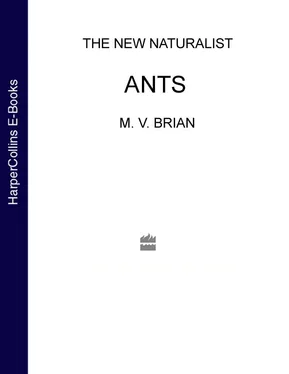Food collection by Formica aquilonia has been studied in detail in an old Caledonian forest. Some five or six trackways leave each nest and go to trees on which prey are caught and aphids are tended for honeydew. After leaving the nest, ants pass round the perimeter and then leave on any one of the tracks. There is just a slight tendency for individuals to use the same track out as they use in. This is oddly at variance with other results which have shown taat Formica rufa and its allies come near to partitioning their foraging grounds between groups of workers that are fairly fixed in individual composition. Different species, different types of food collection or just different times of year may explain this apparent contradiction. Many of the foragers of Formica aquilonia leave the trackways to forage in the neighbouring herbs and observations show that this ‘leakage’ occurs at a constant rate and that the search for prey is quite random until very high prey densities are encountered. Then a recruitment mechanism increases the number of ants entering the area. Temperature affects the rate of flow of traffic on the trackways; a rise from 8 to 18% increases it 5 times. This is probably due to a greater availability of prey at high temperatures, as well as to a greater number of foragers joining in.
Rate of traffic flow is also very much affected by obstacles. If the leaves and twigs are swept from a track the walking rate rises as much as 10%; at 20° C it is normally about a metre a minute. In sections where the tracks pass between rocks traffic density is often so high that collisions are frequent. This causes some delay as the ants stop to examine each other with their antennae. There seems to be very little organization of the flow near the nest: a slight tendency exists for incoming workers to move on the outside and outgoing ones in the centre of the track. In the July of the study there were about seventy thousand foragers active; one in five brought an insect back and it was estimated that about a hundred thousand insects were collected each day.
All this information is not very well received by entomologists primarily interested in the insects which are destroyed. They claim, not without reason, that wood ants impoverish the fauna, but the interrelationships between insects are so complicated and numerous that it is more likely that they merely prevent any one type from predominating and thus preserve a richer mixture at a lower density. As has been pointed out there is plenty of evidence that they concentrate on prey that is momentarily superabundant. Birds of course do this too, and as there are many which live on insects in forests they might be expected to compete with ants. Curiously, the evidence is to the contrary and it is suggested that ants dislodge many insects whilst hunting which they lose and these are caught by birds. This sort of situation is well known in the Tropics where some birds subsist largely by collecting the prey which escapes from the devastating columns of army ants.
The food of Lasius flavus was a mystery until quite recently but it is now known that they eat a great many soil animals, including soft-bodied mites, beetle larvae (notably two species of wireworm), woodlice, other workers of their own species and, in season, queens caught after the nuptial flight. Interestingly enough, they eat more of their own species of queen than of Lasius niger. This last ant is more aggressive and larger than Lasius flavus and it forages both above and below the ground. No doubt as a result it has a much wider range of prey which includes several species of ant, larvae of beetles (again, frequently wireworms), caterpillars, bugs, earwigs, harvesters and woodlice. It has been seen collecting Cabbage White caterpillars in gardens.
In late summer, after a period of dry weather, fires may destroy all the vegetation above the soil surface in heathland. Then the ants Lasius alienus and Tetramorium caespitum eat many soil invertebrates, predominantly the long, slender centipede, Geophilus , and several kinds of wireworm. As already mentioned, food scarcity causes them to search more widely and they meet neighbouring ants much more often, fighting ensues and finally cannibalism. Myrmica eat aphids, springtails, fly larvae, adult flies, spiders and many other small creatures. Some species differences in food must exist as Myrmica scabrinodis is known to hunt nearer the soil in shorter vegetation than Myrmica ruginodis . These ants also remove flesh from the carcasses of dead birds and mammals.
A matter of considerable interest is whether ants control the number of honeydew aphids by butchering and eating surplus ones, and, if they do, how they recognize those that are surplus. Formica rufa is known to kill aphids that crawl away from the main clusters. They might only wander in this way if their food supply was overloaded; it happens particularly after storms which must of course be disturbing and at certain times of year for unknown reasons. Lasius niger , though it frequently collects honeydew from the Black Bean aphis ( Aphis fabae ) on broad beans, never takes any back to its nest, according to one investigator. Others have watched both this species and Lasius flavus carry dead aphids nestwards and feed them to their brood. The tendency with Lasius niger is probably to destroy aphids that can no longer produce honeydew, especially if these try to defend themselves with wax from their cornicles. This species also tends an aphid ( Protrama flavescens ) underground and kills and eats the parasitized ones selectively. Lasius flavus is now known to eat seven species of myrmecophilous aphids. As no other types of aphis are eaten so extensively it seems likely that a special predator/prey relationship has evolved. As they are taken in both young and old stages the basis on which the cull is made is unlikely to be senescence. There seems good evidence that these ants, after removing and eating all the honeydew they need, kill the surplus aphids from protein hunger. One possibility is that too much honeydew is produced when aphids are surplus, with the result that it leaks out and smears them and is decomposed by bacteria so that they are no longer recognized and protected by the foraging ants. Other ecologists have suggested that the honeydew which they offer deflects the ants’ aggressive actions by satisfying another facet of their appetite. There is some support for this in laboratory experiments with Myrmica which have shown that if sugar solution is provided, fewer flies are killed. There is also some evidence that clusters of aphids farthest from the nest are considered more expendable than clusters nearby. Clearly, our understanding of this relationship is rudimentary as yet; it seems that any abnormal state or activity, particularly unnatural movements, positions or smells, may cause the ants to attack instead of protect the aphids and that these abnormal conditions tend to arise more often when the aphids are overcrowded and in need of culling.
Whereas prey provides mostly protein and oil and decomposes quickly, seeds are also rich in starch and they store well, provided germination can be prevented. Seed storage is a regular feature of ants that live in deserts where seed-producing, ephemeral plants may be quite common and the main source of food. Even in this country Myrmica , when it lives in acid grassland, collects the seeds of Potentilla erecta , but whether they are eaten or merely put in the nest is uncertain. Tetramorium caespitum on the other hand collects a great many seeds of grass and heather in late summer, both from the plant and after searching on the ground. Each seed is picked up and carried away individually; curiously enough, ling ( Calluna vulgaris ) is favoured, even though it has the smallest seed. Vast numbers are stored in galleries some 10–30 cm below the soil surface and are fed to the growing grubs in spring after a little preliminary mastication by the workers. They form a staple part of the diet and contribute substantially to the growth of the sexual brood in spring. The seeds never germinate during winter, this may simply be due to the low temperature or because they need light, for there is no evidence that the ants treat them in any way. Seed-eating myrmecines from semi-desert areas apparently take a great deal of trouble to keep their stores dry but this is certainly not the case with Tetramorium caespitum whose galleries are soaking wet for most of the year.
Читать дальше












